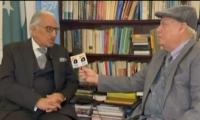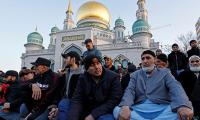I am sitting at breakfast in a hotel in Quetta while writing this article and I just realized that I want to sneeze but I am too conscious to do that.
You guessed it: the Corona virus disease 2019-20, or Covid-19! I read somewhere that, “The world was different. The world feared touch.”(R M James, ‘Hear Me Scream’). I can see how the world fears all ‘sneezes and coughs at this time,’ especially in places where the virus is likely to spread because of geographic location and possible travel routes.
When I woke up in my hotel room this morning, I did what I do every morning. No, I did not drink hot water with lemon and honey. I checked my cell phone, for perpetual ‘fear of missing out’. The Dow was 10 percent off its very recent all-time high, putting it in correction territory, and still sliding further towards a bear market, with fears of it sparking a long overdue global recession.
Meanwhile, Japan has taken the decision to close schools for all of its 13 million children and postpone exams until April, which has sparked hot debate in the country. While some are with the government on this decision, others are criticizing it for burdening households in which both parents are working, who will struggle to leave children at home to both go to work. Commentators are talking about tele-commuting for the Japanese, ready or not.
Balochistan shares a 960-km long border with Iran. A number of religious pilgrims are travelling back to Pakistan at the border crossing at Taftan, where a quarantine area has been established to rule out the presence of Covid-19 infections before letting people travel onward. Yesterday, at the Quetta Secretariat, I overheard officials expressing their concerns about the readiness of the health system to respond to such a spread, and found out later that all schools in Quetta have been closed until at least March 15, 2020, with a high likelihood of this shutdown extending beyond that.
You may remember from the not too distant past (as recently as November, 2019) that the Punjab government closed schools in several cities of Punjab because of smog. School closures are becoming an increasingly common response in even the most developed nations. School districts in the US frequently order school closures to contain the spread of the influenza virus. As the virus spreads across Italy, international schools are being closed, with more widespread closures very likely.
Ana Luiza Minardi, Susannah Hares and Lee Crawfurd from the Center for Global Development have published an article titled ‘Containing the Epidemic: Should Schools Close for Coronavirus?’ (https://www.cgdev.org/blog/containing-epidemic-should-schools-close-coronavirus). They take a refreshingly data-driven approach to answer this question and look at the history of school closures and its effects on the containment of the influenza virus, which is transmitted by the same means as Covid-19.
They conclude that, when timed correctly, school closures significantly contain the spread of disease. However, reopening schools too soon produces an uptick in infections again. They also say that more careful data-driven decisions on partial closures / suspension of classes can yield the same benefits as full school closures. And that school closures impose significant costs like nutritional deficit (where schools provide free meals to disadvantaged students), difficulty of arranging childcare during the day time for households with both parents working, and increased risk of child labour, early marriage, sexual assault, and discontinuation of education.
The authors emphasize the need for governments to consider deploying edtech solutions to continue educating students remotely, even as schools must be closed. This is something that has been enacted for Math, Science, Chinese and PE classes in China for 200 million students during the current crisis since February 17.
But what about us? Amidst all the overwhelming news you will be as pleasantly surprised by a conversation with a colleague from the Knowledge Platform (https://www.knowledgeplatform.com/) yesterday as I was. Knowledge Platform has been leading digital education in Pakistan since around the dawn of the internet in Pakistan in the mid-90s and has stepped forward to offer its digital education product to public schools for free during this disruption. (Let me repeat that” for free).
Their product allows public school students to join their virtual school campus through an online portal and web application. It offers digital lessons (for grades 6 to 10), containing high-quality animated videos, interactive games/activities and assessments that are completely aligned with the national curriculum, and an artificial intelligence engine personalizes the learning for every student.
School teachers will be able to guide students on the platform. Principals and parents can also monitor student engagement on the digital education platform. Their product is already being used in more than 425 schools in Pakistan and over 1,500 schools in Asia, with about 1,000 of them in China. During the current crisis, schools there are using the Knowledge Platform’s online solution to assign homework and engage students from their homes during the current crisis.
Pakistan has 74 million 3G/4G subscribers and 76 million broadband subscribers. This gives us the opportunity to effectively use digital education platforms to ensure continuity and minimize disruption to their education in this crisis. Will provincial governments and the government of Pakistan take them up on this offer? Clearly, our government does not possess the technical / intellectual capacity and resources to think up and implement the kind of novel solutions that are needed. More broadly, this situation presents a textbook case that requires a response only a public-private partnership can deliver.
As I write this I am also having a conversation with an expat living in Quetta for work. We agree that, while certain countries may be better able to control and contain spread, like the Saudis with their recent strict travel restriction despite the presence of a strong healthcare system, Pakistan is certainly not among them.
Tucked between all the made-up ‘home remedies’ for the Covid-19 circulating on Whatsapp and social media is a list of “WHO recommended test centers for the coronavirus in Pakistan.” I confirmed its veracity with an official at the NIH, Islamabad.
This list is notable for its brevity. It lists exactly five cities: Peshawar, Islamabad, Lahore, Karachi and Quetta. Such is the government’s response that we, the citizens, are expected to put our faith in. A sick person in Gujrat, for whom sending his / her children to a school 5 km away is a daily challenge, will have to choose whether to get tested in Islamabad or Lahore. Residents of Rahim Yar Khan are even ‘luckier’, because they will get to choose between three equally distant test centers in far-away Quetta, Karachi or Lahore.
Do I trust my government to formulate an adequate response to the healthcare, education and other challenges posed by Covid-19? I won’t hold my breath (unless someone nearby sneezes).
The writer is an independent education researcher and consultant. She has a PhD in Education from Michigan State University.
Email: arazzaque@gmail.com
Critics argue that strategy is vague, but closer look indicates strategic alignment with global trends and national...
To defeat it, we must distrust bot-driven narratives, to defeat it, we must verify sources before believing or sharing
Too often in emerging markets, digital innovation is treated as standalone goal, with risk relegated to afterthought
As in Pakistan lawfare’s impact and prevalence are increasing, situation is turning murkier
Number of traditions are associated with Eid, such as new clothes and giving and receiving of cash gifts as Eidi
Internationally, there have been misleading theories propounded about so-called slowing of Chinese economy







